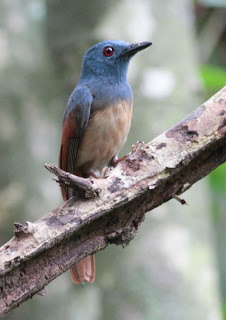
Just 2 of them sighted in the sky of Tanjung
Karang catching the 10am morning thermal and moving south. These are passage
migrant to Indonesia. The great migration starts as early as September
annually.
Welcome to my Malaysian Birding Blog. My blog showcases my legacy of sightings of Malaysian bird in my lifetime - the countdown to 688 species and beyond. Actual numbers of birds you can see in Malaysia is more than 850 and adding.
577/688 species of birds of Malaysia in photos.



| Like other raptors, they have excellent eyesight. To forage, they circle on a thermal to gain height, then glide over water usually low and within 1 km from the shore.They catch their prey by skimming the water surface then snagging the prey in their talons with a backward slash. They don't plunge into the water like Osprey do. White-bellied Fish Eagles don't appear to be highly territorial towards others of their kind. But they make loud harsh cries near important spots like a perch or nest. These can be heard up to 1 km away, perhaps helping to space out the birds and avoid confrontations. |
 Got to shoot my last hornbill subspecies at Tiger Temple in Bangkok Thailand. It was place in a large aviary amongst several other hornbill and ground birds.
Got to shoot my last hornbill subspecies at Tiger Temple in Bangkok Thailand. It was place in a large aviary amongst several other hornbill and ground birds.  New sighting at Nuang Perdik in November 2016. A pair was sighted for a duration of 2-4 weeks here. This shots taken with Fuji XT-2 This is the first time I sighted them in the wild.
New sighting at Nuang Perdik in November 2016. A pair was sighted for a duration of 2-4 weeks here. This shots taken with Fuji XT-2 This is the first time I sighted them in the wild. 



 Little Cuckoo Dove
Little Cuckoo Dove  Female: differs from male in the dark chestnut crown is spotted with black mostly on the forehead. Neck yellow buff barred black & lacking iridescence. Wing coverts more broadly fringed chestnut. Ear coverts yellow buff speckled black. Throat pale buff with feathers around it edged blackish. Upper breast feathers pale basally, blackish laterally & subterminally & variably tipped chestnut which gives a mottled appearance. Belly more yellow rufous vaguely barred. Bill blacker than in male; feet & legs duller purplish red. Juvenile: similar to females but having a more barred & mottled appearance.
Female: differs from male in the dark chestnut crown is spotted with black mostly on the forehead. Neck yellow buff barred black & lacking iridescence. Wing coverts more broadly fringed chestnut. Ear coverts yellow buff speckled black. Throat pale buff with feathers around it edged blackish. Upper breast feathers pale basally, blackish laterally & subterminally & variably tipped chestnut which gives a mottled appearance. Belly more yellow rufous vaguely barred. Bill blacker than in male; feet & legs duller purplish red. Juvenile: similar to females but having a more barred & mottled appearance. Another amazing catch in the old hunt. Bird
life have been in a doldrum here where ground clearing and deforestation is
continuing in front of Perhilitan frontyard but nothing is been done. SOS to
Elizabeth W
Another amazing catch in the old hunt. Bird
life have been in a doldrum here where ground clearing and deforestation is
continuing in front of Perhilitan frontyard but nothing is been done. SOS to
Elizabeth W Likely not Red Turtledoves, the Red Turtledoves should be much redder in
tone, these are likely the Barbary Doves (either originated from Eurasian
Collared Dove or African Collared Dove, its still under debate but African
seemed to be the more favored choice for the time being, the Barbary Dove,
which is completely domesticated is usually regarded as a distinct species, or
a subspecies of the African/European).
Likely not Red Turtledoves, the Red Turtledoves should be much redder in
tone, these are likely the Barbary Doves (either originated from Eurasian
Collared Dove or African Collared Dove, its still under debate but African
seemed to be the more favored choice for the time being, the Barbary Dove,
which is completely domesticated is usually regarded as a distinct species, or
a subspecies of the African/European).